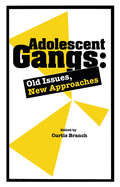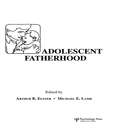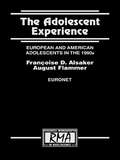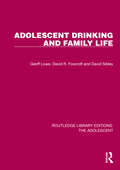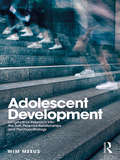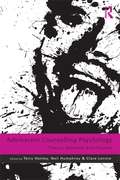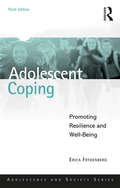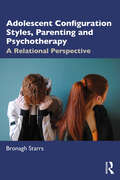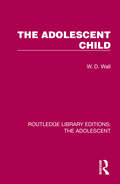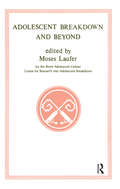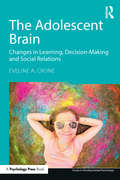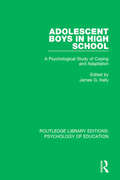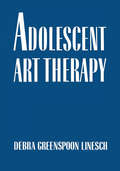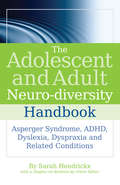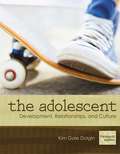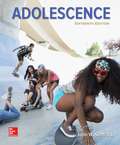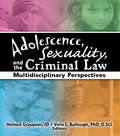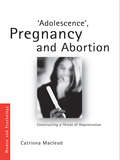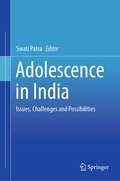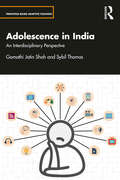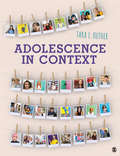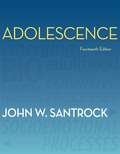- Table View
- List View
Adolescent Gangs: Old Issues, New Approaches
by Curtis W. BranchPublished in 1998, Adolescent Gangs is a valuable contribution to the field of Counseling and School Therapy.
Adolescent Fatherhood
by ARTHUR B. ELSTER and MICHAEL E. LAMBFirst published in 1986. Routledge is an imprint of Taylor & Francis, an informa company.
The Adolescent Experience: European and American Adolescents in the 1990s (Research Monographs in Adolescence Series)
by August Flammer Francoise D. AlsakerThe opening of the borders to Eastern Europe has expanded our view on European diversities and offered new opportunities to examine the effects of the heterogeneity in European cultural backgrounds and political systems on personality and social development. This book is a first step in utilizing the rich cultural resource offered by the large number of cultural units represented in Europe and--at least in part--in the United States. One way to understand the life conditions of adolescents in different countries is to study what they actually do in everyday life and how much time they spend on what types of activities. This book also provides essential and new information about individual and societal priorities and values. Toward this end, the "Euronet" scientists set up a postdoctoral training workshop on adolescent psychology for 10 selected American and 10 selected European participants. The Euronet project comprises 13 different samples--six stemming from Middle and Eastern European countries (Bulgaria, the Czechoslovakian Federal Republic, Hungary, Poland, Russia, and Romania), six from Western European countries (Finland, France, Germany, Norway, French, and German Switzerland), and one from the United States (Michigan). This book reports the results of this large, cross-national, longitudinal study of adolescents and the world(s) in which they live, and is offered to all those who have an interest in adolescence and/or the diversity of Europe. Readers will learn about hundreds of features of adolescence which are more or less characteristic of the cultures, ages, and genders.
Adolescent Drinking and Family Life (Routledge Library Editions: The Adolescent)
by Geoff Lowe David R. Foxcroft David SibleyOriginally published in 1993, Adolescent Drinking and Family Life portrays teenage drinking, not as a symptom of pathology, but as a perfectly normal developmental phase within the context of the home environment. Drinking is predominantly social behaviour and the family is seen as a major agent of socialization. The authors have therefore explored family dynamics and the influence which the home environment has upon adolescent drinking to come up with a new theoretical model. A major feature of this approach is the interaction of ideas from family life psychology and human geography. The authors present a typology of domestic regimes illustrated by case studies of boundary enforcement and transgression. The general theme of boundary transgression, applied here to both the psychosocial environment and built form, represents an interesting new theoretical perspective. The integration of these two fields is an innovation which should stimulate further interdisciplinary work in adolescence and addiction research. Adolescent Drinking and Family Life will be interesting to researchers and practitioners in adolescence, family dynamics, and alcohol as well as any social scientist with an interest in the link between behaviour and the home environment. This new approach had important implications for health education and for interventions concerned with adolescent alcohol use at the time. Today it can be read in its historical context.
Adolescent Development: Longitudinal Research into the Self, Personal Relationships and Psychopathology
by Wim MeeusThis groundbreaking book provides students and researchers with a unique overview of the longitudinal study of the development of young people from the ages of 12 to 25. It offers a comprehensive introduction into the multiple theories on the development of the self, personal relationships and psychopathology in adolescence, alongside a non-statistical overview of the many longitudinal models used to study development. The book includes key topics such as the development of the self, adolescent identity and personality; the development of parent-adolescent relationships; friendships and the understanding of others; and the development of psychosocial problems such as anxiety, depression, delinquency, aggression, and substance use. Meeus highlights multiple findings showing how these processes are integrated and identifies eight fundamental patterns of adolescent development to help determine why most adolescents develop into mature and organized individuals towards the end of this life stage, whilst a substantial minority show an inability to mature. It is essential reading for graduate students and researchers in adolescent development and anyone seeking to use longitudinal research methodology in the social and behavioral sciences.
Adolescent Counselling Psychology: Theory, Research and Practice
by Terry Hanley Neil Humphrey Clare LennieAdolescent Counselling Psychology: Theory Research and Practice provides a thorough introduction to therapeutic practice with young people. As an edited text, it brings together some of the leading authorities on such work into one digestible volume. The text is divided into three major sections.The first provides a context to therapeutic work with young people. This outlines the historical background to such work, the types of settings in which individuals work and the allied professions that they will encounter. Following on from this, the second section introduces the psychology of adolescence and provides an overview of the research into youth counselling. Finally, the third section considers more applied issues. Initially the infrastructure of counselling services is discussed before moving on to reflect upon pluralistic therapeutic practice. To end, the ways in which outcomes may be assessed in such work are described. In covering such a wide territory this text acts as an essential resource to practicing counselling psychologists and other mental health professionals. It provides a foundation to the work that individuals are undertaking in this arena and advocates that individuals enter into therapeutic work in a critically informed way. At the heart of such considerations is the need to utilise psychological theory alongside research findings to inform therapeutic decision making.
Adolescent Coping: Promoting Resilience and Well-Being (Adolescence and Society)
by Erica FrydenbergHow do young people cope with the multitude of difficult situations and scenarios that are associated with growing up, like anxiety and depression, as well as illness, rejection and family breakdown? How can we facilitate and encourage, through a combination of health, well-being and positive mindset, healthy development during adolescence and beyond? With a substantial focus on the positive aspects of coping, including an emphasis on developing resilience and the achievement of happiness, Erica Frydenberg presents the latest developments in the field of coping. Adolescent Coping highlights the ways in which coping can be measured and implemented in a wide range of circumstances and contexts, with suggestions for the development of coping skills and coping skills training, and it provides strong scholarly evidence for the concepts and constructs that it promotes as providing a pathway to resilience. The work is framed as an ongoing interaction between individuals and their environments as represented by the psychosocial ecological model of Bronfenbrenner. The major theories of coping are articulated that take account of the transactional model, resources theories and proactive models of coping. Areas of recent interest such as neuroscience and epigenetics are included, alongside a new chapter, ‘Cyberworld’, which provides insights on new and relevant topics such as mindfulness and the impact of social media as they relate to coping in the contemporary context. Adolescent Coping will be of interest to practitioners in psychology, social work, sociology, education and youth and community work as well as to students on courses in adolescent development in these fields.
Adolescent Configuration Styles, Parenting and Psychotherapy: A Relational Perspective
by Bronagh StarrsMental health has become the principal concern as adolescents struggle with a host of issues such as anxiety, academic pressures, gender, substances, social media, complicated family compositions and a vulnerable planet. This book provides psychotherapists with a clear theoretical understanding and practical application for navigating the increasingly complex adolescent experience as young people adjust and respond to the present- day world. Starrs presents a contemporary understanding of adolescence, identifying three principal character styles and offering experience- near descriptions of the modernday adolescent. The author demonstrates how each configuration style in adolescence elicits a predictable response in parents and examines the challenges and dilemmas facing parents in today’s world, highlighting the patterns and pitfalls which often render parental interventions ineffective. Developmentally attuned parenting strategies are outlined, pertaining to each configuration style. The in depth analysis of adolescent process and parental response has implications for the therapeutic encounter. Intervention focuses both on one- to- one work with the adolescent and parental involvement. The complexity of working with adolescents and parents who demonstrate psychological entrenchment is also outlined. This highly readable, original and exceptional contribution is suitable for psychotherapists, allied professionals and parents alike.
The Adolescent Child (Routledge Library Editions: The Adolescent)
by W. D. WallOriginally published in 1948, The Adolescent Child provided vital information on adolescence for parents, teachers, club leaders, social and religious workers and welfare supervisors in factories at the time. With research from both the UK and the US the author looks at the psychology of the adolescent through the many stages they encounter, from physical and emotional changes; self-identity; love and friendship to education and work. Today it can be read and enjoyed in its historical context.
Adolescent Breakdown and Beyond
by Moses LauferThis is the second monograph published by Karnac Books on behalf of the Brent Adolescent Centre/Centre for Research into Adolescent Breakdown. Drawing on the Centre's unique pool of expertise in the field, this book contains papers giving up-to-date psychodynamic perspectives on adolescent breakdown by leading clinical experts. These cover a range of topics, such as the differing developments in male and female adolescents, and the particular problems of psychotherapeutic intervention with them. It also includes the proceedings of a conference on the subject held in October 1995. Here the issues of adolescent breakdown are discussed in the wider context which workers in the caring professions must consider. Overall, this volume provides a concise, contemporary overview of a topic whose importance is increasingly being recognized both inside and outside the psychotherapeutic community. Contributors: Anthony Bateman, Debbie Bandler Bellman, Gabrielle Crockatt, Maxim de Sauma, Domenico di Ceglie, Sara Flanders, Maurice H. Friedman, Christopher Gibson, Kevin Healy, M. Egle Laufer, Kamil Mehra, Joan Schachter, Nicholas Temple, Peter Wilson
The Adolescent Brain: Changes in learning, decision-making and social relations (Essays in Developmental Psychology)
by Eveline A. CroneIn recent years there have been tremendous advances in understanding how brain development underlies behavioural changes in adolescence. Based on the latest discoveries in the research field, Eveline A. Crone examines changes in learning, emotions, face processing and social relationships in relation to brain maturation, across the fascinating period of adolescent development. This book covers new insights from brain research that help us to understand what happens when children turn into adolescents and then into young adults. Why do they show increases in sensation-seeking, risk-taking and sensitivity to opinions of friends? With the arrival of neuroimaging techniques, it is now possible to unravel what goes on in an individual’s brain when completing cognitive tasks, when playing computer games, or when engaging in online social interactions. These findings help reveal how children learn, control thoughts and actions, plan activities, control emotions and think about intentions of others, offering a new perspective on behaviour and motivations of adolescents. This is the first comprehensive book to cover the many domains of adolescent brain development, stretching from cognitive to affective to social development. It is valuable reading for students and researchers in the field of adolescent development and developmental cognitive neuroscience and those interested in how the developing brain affects behaviour in the teenage years.
Adolescent Boys in High School: A Psychological Study of Coping and Adaptation (Routledge Library Editions: Psychology of Education)
by James G. KellyOriginally published in 1979, the research reported in this volume is based on investigations of how tenth-grade boys cope and adapt to the high-school environment in, specifically, two high schools in suburban Detroit in 1970. In addition to information about the ways that students relate to the high school environment, this volume presents examples of how multiple research methods can be used to investigate the expression of complex person and environment relationships. This volume has been prepared to illustrate the application of an ecological point of view for research on person-environment relationships. It was hoped that the community psychologist, social psychologist, and school psychologist interested in doing research with adolescents and the high school environment would find the presentation of research methods informative and encouraging. For those readers involved in teaching and administering in secondary education, the volume was an example of how research can illustrate the ongoing personal and social characteristics of students and the high school environment.
Adolescent Boys
by Niobe Way Judy Y. ChuA flurry of best-selling works has recently urged us to rescue and protect boys. They have described how boys are failing at school, acting out, or shutting down emotionally. Lost in much of the ensuing public conversation are the boys themselves--the texture of their lives and the ways in which they resist stereotypical representations of them. Most of this work on boys is based primarily on middle class, white boys. Yet boys from poor and working class families as well as those from African American, Latino, and Asian American backgrounds need to be understood in their own terms and not just as a contrast to white or middle class boys. Adolescent Boys brings together the most up-to-date empirical research focused on understanding the development of boys from diverse racial, ethnic, and socioeconomic backgrounds. The authors show how the contexts of boys' lives, such as the schools they attend shape their identities and relationships. The research in this book will help professionals and parents understand the diversity and richness of boys' experiences.
Adolescent Art Therapy
by Debra G. LineschAdolescent Art Therapy is an attempt to delineate the issues and techniques that are particular to the practice of art psychotherapy with an adolescent population. Adolescent Art Therapy provides a developmentally oriented rationale for the use of art psychotherapy with the adolescent patient.
The Adolescent and Adult Neuro-diversity Handbook: Asperger Syndrome, ADHD, Dyslexia, Dyspraxia and Related Conditions
by Sarah HendrickxIncreasing numbers of adults are realising that they have been living with an undiagnosed developmental condition, yet most information and support focuses on children. This leaves many adults confused and in the dark. The Adolescent and Adult Neuro-Diversity Handbook is a handy first-reference point guide to the full range of developmental conditions as they affect adolescents and adults. Each chapter focuses on a different condition, describing its history, causes and characteristics, its implications for the individual, diagnosis and assessment, treatments and approaches, and strategies for providing support and self-support. A wide range of conditions are covered, including Autistic Spectrum Disorders, Dyslexia, Dyspraxia, ADHD, OCD, Tourette's and Anxiety Disorders. The Adolescent and Adult Neuro-Diversity Handbook is an invaluable resource for health and social care practitioners, as well as for individuals who feel that they may be living with an undiagnosed developmental condition.
The Adolescent and Adult Neuro-diversity Handbook: Asperger Syndrome, ADHD, Dyslexia, Dyspraxia and Related Conditions
by Claire Salter Sarah HendrickxIncreasing numbers of adults are realising that they have been living with an undiagnosed developmental condition, yet most information and support focuses on children. This leaves many adults confused and in the dark. The Adolescent and Adult Neuro-Diversity Handbook is a handy first-reference point guide to the full range of developmental conditions as they affect adolescents and adults. Each chapter focuses on a different condition, describing its history, causes and characteristics, its implications for the individual, diagnosis and assessment, treatments and approaches, and strategies for providing support and self-support. A wide range of conditions are covered, including Autistic Spectrum Disorders, Dyslexia, Dyspraxia, ADHD, OCD, Tourette's and Anxiety Disorders. The Adolescent and Adult Neuro-Diversity Handbook is an invaluable resource for health and social care practitioners, as well as for individuals who feel that they may be living with an undiagnosed developmental condition.
The Adolescent: Development, Relationships, and Culture (13th edition)
by Kim Gale DolginThe book is as comprehensive as possible within the confines of one text. The adolescent is discussed within the context of contemporary society. Material includes both theory and life experiences of adolescents and discusses physical, intellectual, emotional, psychosexual, social, familial, educational, and vocational aspects of adolescent development and behavior. It also reviews psychosocial problems of adolescents.
Adolescence (Sixteenth Edition)
by John W. SantrockConnecting research and results. As a master teacher, John Santrock connects students to current research and real-world application, helping students see how adolescent psychology plays a role in their own lives and future careers. Through an integrated, personalized digital learning program, students gain the insight they need to study smarter and improve performance.
Adolescence, Sexuality, and the Criminal Law: Multidisciplinary Perspectives
by Vern L BulloughGain an understanding of the threat to freedom that is posed by state regulation of adolescent sexual behaviorSexual autonomy encompasses both the right to engage in wanted sexual activity and the right to be free and protected from unwanted sexual aggression. Only when both aspects of adolescents&’ rights are recognized can human sexual dignity be fully respected. In Adolescence, Sexuality, and the Criminal Law, experts from several disciplines use case studies, legal analysis, empirical examinations, and tables and figures to provide you with an insightful contribution to the debate surrounding child sexual abuse.Much has been written about the undisputedly essential fight against child sexual exploitation. In Adolescence, Sexuality, and the Criminal Law, experts investigate for the first time what distinguishes the sexual contacts of adolescents from those of children and why they should be treated separately. This updated version of the papers delivered to the International Association for the Treatment of Sex Offenders in 2002 is an essential guide for lawmakers, sexologists, psychologists, and lawyers interested in an interdisciplinary approach to adolescent sexuality and the criminal law. This resource carefully examines child sexual abuse laws that fail to distinguish between children and adolescents. The text includes discussions of the history of the age of consent, adolescent sexuality, relations between adolescents and adults, and adolescent prostitution and pornography that will leave you better informed about the sexual rights of adolescents and the criminal politics of youth protection.Adolescence, Sexuality, and the Criminal Law examines adolescent sexuality and the various policies that threaten adolescents&’ autonomy, including: the question of youthful sexuality and how society has attempted to deal with it recent attempts to deny youthful sexuality through abstinence or changes in the law intergenerational sexual interaction child pornography and much more!As the debate surrounding child sexual abuse laws escalates, the value of this authoritative and timely text will continue to increase. Whether you are a lawmaker, a sexologist, a social worker, a lawmaker, or a lawyer, Adolescence, Sexuality, and the Criminal Law is a resource that you&’ll return to again and again as you work to understand the importance of adolescent sexual rights.
'Adolescence', Pregnancy and Abortion: Constructing a Threat of Degeneration (Women and Psychology)
by Catriona I. MacleodWinner of the Rhodes University Vice-Chancellor's Book Award 2012! Winner of the 2011 Distinguished Publication Award of the Association for Women in Psychology! Why, despite evidence to the contrary, does the narrative of the negative consequences of teenage pregnancy, abortion and childbearing persist? This book argues that the negativity surrounding early reproduction is underpinned by a particular understanding of adolescence. It traces the invention of "adolescence" and the imaginary wall that the notion constructs between young people and adults. Macleod examines the entrenched status of "adolescence" within a colonialist discourse that equates development of the individual with the development of civilisation, and the consequent threat of degeneration that "adolescence" implies. Many important issues are explored, such as the invention of teenage pregnancy and abortion as a social problem; issues of race, culture and tradition in relation to teenage pregnancy; and health service provider practices, specifically in relation to managing risk. In the final chapter, an argument is made for a shift from the signifier "teenage pregnancy" to "unwanted pregnancy". Using data gathered from studies worldwide, this book highlights central issues in the global debate concerning teenage pregnancy. It is ideal for academics, and students of health psychology, women’s studies, nursing and sociology, as well as practitioners in the fields of youth and social work, medicine and counselling.
Adolescence in India: Issues, Challenges and Possibilities
by Swati PatraThis book provides a comprehensive, in-depth and practical approach towards an understanding of the multitude challenges of adolescence in India. Going beyond the traditional ‘storm, stress and strain’ view of adolescents, it focuses on the strengths of adolescents and highlights a community approach towards an understanding of adolescents. The book is divided into three sections. Section 1 introduces the concept of adolescence in the Indian context, discusses the identity development and peer relations in adolescents. Section 2 deliberates on issues and challenges such as depression, suicide, violence, substance use and behavioural addiction, keeping in mind the Indian socio-cultural context. It also highlights concerns of adolescents related to disabilities. Section 3 provides various prevention and intervention measures including both individual-based and group-based interventions to deal with these challenges, thereby facilitating the journey of adolescents. It helps the reader to focus on the positive development of the adolescents. The book is useful for students in psychology, education, counselling, mental health and development. It is also a great resource book for professionals working in the field of health in general and mental health in particular.
Adolescence in India: An Interdisciplinary Perspective (Principles-based Adaptive Teaching)
by Gomathi Jatin Shah Sybil ThomasAdolescence in India: An Interdisciplinary Perspective highlights the need and importance of studying adolescence in the domain of education. Using an interdisciplinary approach, it discusses adolescence from the perspective of sociology, psychology, education and health studies. Against the backdrop of economic development and globalization, the book looks at adolescence in the changing social milieu. It offers an understanding of adolescence by exploring the socio-cultural influences on adolescents and their interactions in various spaces like the school, among peers, family and the media. The book reflects on classroom group processes and instructional practices for better psychosocial growth of adolescents as well as discusses the need for a greater emphasis on making resources available for adolescents to realise and strengthen their skills and agency. The book outlines various life-skills policies and programmes in India and uses vignettes, anecdotes, emerging classroom discussions, case studies, activities, and self-assessment tools and questionnaires to facilitate a deeper understanding of the concept. The book will be of interest to students, teachers, and educators in teaching programmes including educational psychology, adolescent psychology, and human development. It will also be useful for policymakers, NGOs, and public and private sector bodies who work in the field of adolescent psychology.
Adolescence in Context: Lives in Context
by Dr. Tara L. KutherAdolescence: Lives in Context is a topically oriented text for the Adolescence and Emerging Adulthood development course organized around three key themes: the centrality of context, the importance of research, and the applied value of developmental science. The text, developed by teacher and scholar Tara Kuther, will be written to engage students through her digestible, student-friendly writing style. Adolescence: Lives in Context will deliver current and classic research, foundational theories and will help students to comprehend how those theories apply to their future careers and own lives through a lens of contexts across each developmental stage and topic. ?
Adolescence in Context: Lives in Context
by Dr. Tara L. KutherAdolescence: Lives in Context is a topically oriented text for the Adolescence and Emerging Adulthood development course organized around three key themes: the centrality of context, the importance of research, and the applied value of developmental science. The text, developed by teacher and scholar Tara Kuther, will be written to engage students through her digestible, student-friendly writing style. Adolescence: Lives in Context will deliver current and classic research, foundational theories and will help students to comprehend how those theories apply to their future careers and own lives through a lens of contexts across each developmental stage and topic. ?
Adolescence (Fourteenth Edition)
by John W. SantrockMore students learn from John Santrock’s Adolescence than from any other text in this field. The 14th edition combines proven pedagogy and the most current research to provide a market leading presentation of adolescence. This time tested text provides compelling contemporary research, including updates from eleven leading experts in the field. The text's accessible presentation, plentiful applications and engaging writing foster increased mastery of the content. The new edition includes substantially expanded material on diversity and culture, adolescents’ and emerging adults’ health and well-being, including numerous recommendations for improving the lives of adolescents, and expanded emphasis on the positive aspects of adolescent development.
